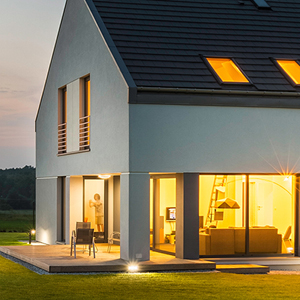
BUILDING, CONSTRUCTION & DESIGN
Vinyl is often referred to as the “infrastructure plastic,” and with good reason. Approximately 70 percent of PVC is used in building and construction applications. Vinyl is used so widely in the construction industry because of its durability, easy installation and cost-effectiveness.
The use of plasticizers differentiates flexible vinyl products from rigid. Generally speaking, PVC materials would be classified as rigid when plasticizers have not been added to the resin, such as pipe, siding, windows, and fence, deck and rail. PVC flooring, wallcovering and reflective roofing are classified as flexible, and are available in a multitude of styles and colors. Vinyl’s durability is an important environmental benefit, because the longer a product lasts, the less energy and other resources must be expended to make and install replacement products.
Roofing
Flexible and lightweight, vinyl roofing membranes have performed beautifully for more than 30 years in the industrial and commercial roofing sector. Thermoplastic and single-ply, vinyl roofing membranes offer a clean, quick, and safe alternative to built-up roofs—with greater design flexibility. They are extremely durable and can remain watertight even in extreme weather. Vinyl roofing membranes can be used in mechanically attached systems, adhered systems, and ballasted systems, and are well suited for heat-welding of seams in a wide range of temperatures. For more information on vinyl roofing, please visit the Chemical Fabrics and Film Association (CFFA).
Siding
In recent years, vinyl siding has increased in popularity and now accounts for about 50% of all residential and light commercial building exteriors. That’s because vinyl siding offers more benefits than other options—durability, ease of maintenance, and low cost of installation. It also offers more design choices, so whether a project is traditional or modern, vinyl siding can accommodate whatever look you need with its wide range of finishes, textures, and colors. For more information and resources on vinyl siding, please visit the Vinyl Siding Institute (VSI).
Flooring
Vinyl flooring has become a valued material for many designers and architects, especially in spaces that endure heavy traffic (such as retail stores) or frequent cleaning (such as healthcare facilities). Vinyl flooring, also called “resilient flooring,” is durable, easy to maintain, moisture-resistant, and has antimicrobial properties. It comes in a variety of styles and is available in either tile or sheet form. In addition to being a popular choice for commercial spaces, vinyl is often used in residential kitchens and bathrooms. For more information and resources on vinyl flooring, please visit the Resilient Floor Covering Institute (RFCI).
Windows & Doors
Vinyl now rivals traditional materials like wood in fenestration applications like windows and glass doors, providing comparable or better energy efficiency, aesthetics, design flexibility, and cost effectiveness. Used in many types of residential and light commercial construction, vinyl windows and glass doors are constructed in much the same way as aluminum or wood windows, but with a chambered vinyl extrusion forming the frame around the glass. For more information and resources on vinyl windows and doors, please visit the Fenestration & Glazing Industry Alliance (FGIA).
Wallcovering
Vinyl is a great choice for residential and commercial walls and furnishings. Vinyl wallcoverings have grown in popularity because they offer a wide range of finishes and colors along with easy maintenance and durability. Wall protection products like guardrails and kickbases offer durable, easy-to-clean ways to protect both walls and objects that come into contact with them—something especially helpful in settings like healthcare facilities. Vinyl upholstery is a cost-efficient choice for furnishings that are subjected to a lot of use and need to be cleaned easily. Available in all kinds of patterns and textures, vinyl upholstery looks great in a variety of interiors. For more information and resources on vinyl flooring and wallcovering, please visit the Wallcovering Association (WA) and CFFA.
Fencing, Decking & Railing
Vinyl fencing, decking, and railing continue to gain popularity in the building products industry. Vinyl offers less maintenance and more durability than the wood and metal traditionally used in these products. And because of these benefits, it provides an overall lower lifecycle cost. But vinyl fencing, decking, and railing products are more than just practical, they’re also suitable for a wide range of styles—from the standard and traditional to the innovative and contemporary.

